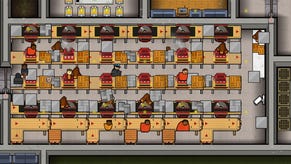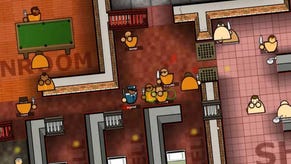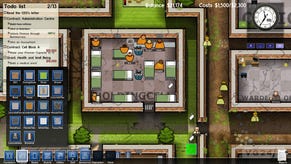A Visitation with the Wardens of Prison Architect
Mark Morris and Chris Delay of Introversion Software talk about the challenges of making a dark, depressing subject into an addictive simulation.
This article first appeared on USgamer, a partner publication of VG247. Some content, such as this article, has been migrated to VG247 for posterity after USgamer's closure - but it has not been edited or further vetted by the VG247 team.
USg: So, is this meant to explicitly be a simulation of the American prison system? Is that what you were going for? I wasn’t sure if it was supposed to be distinctly American – I mean, knowing that you guys are not from America, but there is the death sentence in this game and things like that…
CD: It’s optional; we let the player do it if they want to. I mean, our guiding principle was that we would let the player do anything you can do in the prison system, in any country, and so we wouldn’t set it in any one country. The problem with that, obviously, is there is a stereotype of prisons, which is jail bars and orange jumpsuits. And yet, just the art for the guards and everything, it’s just a very stereotypical prison guard. And most of that stereotype comes from America, so as soon as we started using all those stereotypes, people assumed it was set in America.
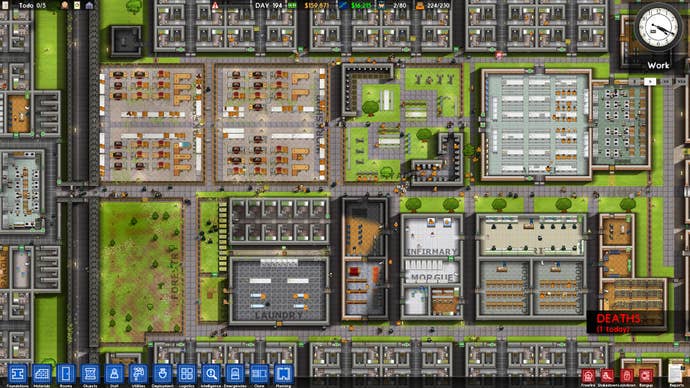
USg: Yeah, I think everyone is watching Orange is the New Black, too, that TV show, so naturally everyone is just thinking about prison now. I think you guys launched a year before that show, so you got it just as it was getting huge. That’s probably helpful.
CD: It’s a great program, I actually love it. It’s actually a great TV show; it’s hard to avoid, I mean, it’s hard to imagine how we could’ve rendered the game world and not have it look like it was American, because that’s what people would expect a prison game to look like, and making the game beatable was a very high priority, so it needs to be really clear. I mean, prisoners are wearing orange jumpsuits because they’re bright orange, which means you can see them, you can tell them apart from guards. There’s a very practical reason, and other countries have orange jumpsuits now, and guards in blue uniforms. I think in the UK, they have white uniforms, don’t they? And ties… black ties.
MM: Yeah, and blue trousers under.
USg: With Prison Architect, are you trying to talk about prison reform, or what actually happens in prison? Are you trying to… maybe not expressly give a message, but at least give people insight into this world that maybe they’re not aware of?
CD: Yeah, insight into prisons is what we’re interested in. We tried very hard not to apply ourselves to the game and not to make even the story to not have any kind of weight to it. And certainly in a sandbox, you can build an extremely liberal, extremely sort of Scandinavian-style prison that’s all about reform and education and rehabilitation, and it’s all focused on bringing in prisoners and convicts and reforming them so that when they leave they’re no longer criminals. And it’s possible to do, people have done that, and we allow that in the game, and we also allow the [other extreme], Death Row, and armed guards everywhere, and supermax American-style… you know, a thousand prisoners in a very small area, crammed in. The game doesn’t judge you; they’re both successful strategies.
The Death Row [opening] was definitely a deliberate choice on our part to make the first chapter the darkest chapter, and that’s about setting the tone for the game and putting the player in the right mindset, that you really aren’t building a theme park or a hospital or something. It’s a different feel, and it’s not just a visual reskin of a hotel building game or something. Actually, the theme fundamentally affects the game, and that was the best way we could think to do it.
USg: So there’s a lot going on when you’re talking about prisons, and I’m just wondering if there’s any subjects you won’t touch. I haven’t played a lot of the game, but I assume you don’t deal with the issue of sexual abuse of prisoners by prisoners, by guards, things like that.
CD: We don’t have rape in the game, and I think that was a conscious choice…
USg: That’s a very smart choice.
CD: It’s almost like we knew at the onset, you get big fights in the showers and they’re all in there naked, and you just don’t go any further than that, you just say “there was a terrible incident in the shower” and the guards have to come in, and we just leave it that way because I don’t think – the thing that’s always guided me is “we won’t put anything in the game unless it’s actually an interesting game mechanic.” Everything we’ve put in, even Death Row and the really controversial stuff like gangs and things, they only made it into the game when they became game mechanics, because it is a game first. And it’s at its best when it’s a game mechanic combined with a really interesting issue. So, the difference between a fight in the showers and a rape in the showers is mechanically zero. There’s no difference from a gameplay standpoint, and if we’ve got rape in the game, it would just be controversy for no game—
MM: It wouldn’t improve the game.
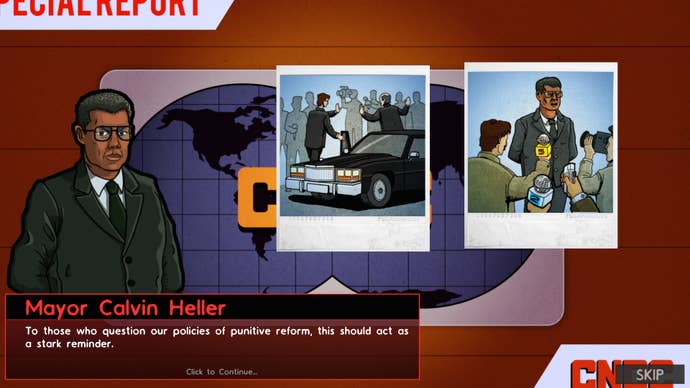
CD: It wouldn’t improve the game or make it any better, and in fact it would probably make it – I think it would cross the line, actually. I think there might be a line somewhere, and I think that would cross it.
MM: Yeah, I don’t agree with you; I’m not sure there is, but I think in our game, in our context, what Chris says is right, you know? It would add nothing to the game, and fundamentally, we’re game developers. And so dealing with specifically rape for no other reason than to deal with that in video games and be the first and be out here doing loads of interviews about why we dealt with that would be just a little bit crass – feel a bit wrong to me, feel like we would be exploiting that terrible thing.
USg: I’m just wondering, have any former prisoners or prison staff members—have they commented on your game, do they play your game; I’m just wondering what kind of feedback from those people, what that’s like?
MM: We’ve had several comments from ex-inmates… certainly in the early days, a lot of time talking to someone who doesn’t want to be identified about how things work within prison. A lot of correctional officers play Prison Architect, which is interesting to me. They go and live it, then they come home and go and play it. A lot of what happens in prisons is kind of straightforward, how a canteen system is going to set up and work. But there are subtleties involved in prison life, and that’s what the guards have helped us to understand. Some of the things I was most interested to learn about was the prisoners’ ability to switch cells. I thought you’d just be thrown into a cell and that would be the end of it, but no, if a prisoner wants to move cells, there are ways they can do that.
CD: There are prisons with three- or four-hundred inmates, and so there’s a limit to what you can see in the game, and to some extent, we’re happy with that because we think that reflects reality, and you can’t tend to the needs of every one of your prisoners individually. So you have to make broad strokes that will positively affect a large number of prisoners, and those broad strokes often completely neglect people on the fringes or people with slightly different requirements, and I think there’s something interesting about that.

